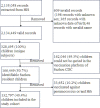Incidence of community-acquired pneumonia among children under 5 years in Suzhou, China: a hospital-based cohort study
- PMID: 38171617
- PMCID: PMC10773396
- DOI: 10.1136/bmjopen-2023-078489
Incidence of community-acquired pneumonia among children under 5 years in Suzhou, China: a hospital-based cohort study
Abstract
Objectives: To depict the seasonality and age variations of community-acquired pneumonia (CAP) incidence in the context of the COVID-19 impact.
Design: Retrospective cohort study.
Participants: The observational cohort study was conducted at Soochow University Affiliated Children's Hospital from January 2017 to June 2021 and involved 132 797 children born in 2017 or 2018. They were followed and identified CAP episodes by screening on the Health Information Systems of outpatients and inpatients in the same hospital.
Outcome: The CAP episodes were defined when the diagnoses coded as J09-J18 or J20-J22. The incidence of CAP was estimated stratified by age, sex, birth year, health status group, season and month, and the rate ratio was calculated and adjusted by a quasi-Poisson regression model. Stratified analysis of incidence of CAP by birth month was conducted to understand the age and seasonal variation.
Results: The overall incidence of CAP among children aged ≤5 years was 130.08 per 1000 person years. Children aged ≤24 months have a higher CAP incidence than those aged >24 months (176.84 vs 72.04 per 1000 person years, p<0.001). The CAP incidence increased from October, peaked at December and January and the highest CAP incidence was observed in winter (206.7 per 1000 person years, 95% CI 204.12 to 209.28). A substantial decline of CAP incidence was observed during the COVID-19 lockdown from February to August 2020, and began to rise again when the communities reopened.
Conclusions: The burden of CAP among children is considerable. The incidence of CAP among children ≤5 years varied by age and season and decreased during COVID-19 lockdown.
Keywords: Child protection; China; Epidemiology.
© Author(s) (or their employer(s)) 2024. Re-use permitted under CC BY-NC. No commercial re-use. See rights and permissions. Published by BMJ.
Conflict of interest statement
Competing interests: None declared.
Figures



Similar articles
-
Hospitalization Rate and Population-based Incidence of Hospitalization for Community-acquired Pneumonia Among Children in Suzhou, China.Pediatr Infect Dis J. 2018 Dec;37(12):1242-1247. doi: 10.1097/INF.0000000000002016. Pediatr Infect Dis J. 2018. PMID: 29570586
-
Risk Factors for Severe Community-aquired Pneumonia Among Children Hospitalized With CAP Younger Than 5 Years of Age.Pediatr Infect Dis J. 2019 Mar;38(3):224-229. doi: 10.1097/INF.0000000000002098. Pediatr Infect Dis J. 2019. PMID: 29746377
-
Incidence of community-acquired pneumonia in urban China: A national population-based study.Vaccine. 2020 Dec 14;38(52):8362-8370. doi: 10.1016/j.vaccine.2020.11.004. Epub 2020 Nov 13. Vaccine. 2020. PMID: 33199077
-
Rates of hospitalization for community-acquired pneumonia among US adults: A systematic review.Vaccine. 2020 Jan 22;38(4):741-751. doi: 10.1016/j.vaccine.2019.10.101. Epub 2019 Dec 13. Vaccine. 2020. PMID: 31843272
-
Aggregate and hospital-level impact of national guidelines on diagnostic resource utilization for children with pneumonia at children's hospitals.J Hosp Med. 2016 May;11(5):317-23. doi: 10.1002/jhm.2534. Epub 2016 Jan 13. J Hosp Med. 2016. PMID: 26762571 Free PMC article. Review.
Cited by
-
Real-world efficacy and safety of cefepime for pediatric community-acquired pneumonia: a propensity score-matched study.Front Cell Infect Microbiol. 2025 Jun 18;15:1616184. doi: 10.3389/fcimb.2025.1616184. eCollection 2025. Front Cell Infect Microbiol. 2025. PMID: 40606637 Free PMC article.
-
Differences in pulmonary microbiota of severe community-acquired pneumonia with different pathogenic microorganisms in children.BMC Pediatr. 2025 Jun 3;25(1):449. doi: 10.1186/s12887-025-05819-x. BMC Pediatr. 2025. PMID: 40462041 Free PMC article.
-
Can Lung Ultrasound Act as a Diagnosis and Monitoring Tool in Children with Community Acquired Pneumonia? Correlation with Risk Factors, Clinical Indicators and Biologic Results.J Clin Med. 2025 Jul 27;14(15):5304. doi: 10.3390/jcm14155304. J Clin Med. 2025. PMID: 40806926 Free PMC article.
References
-
- Troeger C, Blacker B, Khalil IA, et al. . Estimates of the global, regional, and national morbidity, mortality, and aetiologies of lower respiratory infections in 195 countries, 1990-2016: a systematic analysis for the global burden of disease study 2016. Lancet Infect Dis 2018;18:1191–210. 10.1016/S1473-3099(18)30310-4 - DOI - PMC - PubMed
Publication types
MeSH terms
LinkOut - more resources
Full Text Sources
Medical
Miscellaneous
